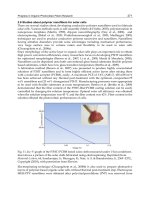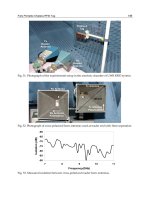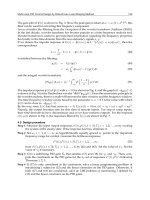Aircraft Design: Synthesis and Analysis - part 9 pot
Bạn đang xem bản rút gọn của tài liệu. Xem và tải ngay bản đầy đủ của tài liệu tại đây (8.78 MB, 48 trang )
y
engine
is the distance from fuselage centerline to critical engine
T is the take-off thrust for the critical engine
l
v
is the vertical tail length (distance from c.g. to vertical tail a.c.)
The total drag increment is the sum of the windmilling term and the trim drag.
These climb gradients are determined for all applicable weights, altitudes, and temperatures. From this
data, the maximum permissible weight for a given condition are established.
Operational Climb
Normal climb to cruise altitude is carried out at the speed for best overall economy (high speed climb)
which is considerably faster than the speed for maximum rate of climb, which, in turn, is much faster
than the speed for maximum climb gradient. If fuel quantity is limiting, climb may be performed at the
speed for best fuel economy (long range climb speed), a speed between the best overall economy climb
speed and the best gradient climb speed. Speed schedules are selected to be easily followed by the pilot
with available instrumentation. Recent introduction of automatic flight directors, makes this task easier.
The computed climb rates are integrated to produce time, fuel, and distance to climb to any altitude.
For approximate calculations, the additional fuel to climb to altitude (as compared with cruising the same
distance at the cruise altitude) can be approximated by adding an increment to the total cruise fuel. This
increment has been determined for a wide range of weights for the DC-9-30, the DC-8-62, and the DC-
10-10. The results, expressed as a percentage of take-off weight are summarized in the following figure.
For different aircraft such as SST's we might think more fundamentally about the cause of this fuel
increment. With a rough estimate of the overall propulsion efficiency, we can express the extra fuel used
in terms of the change in kinetic and potential energy. The net result, expressed as a percentage of take-
off weight, is:
W
climb_fuel_inc
/ W
to
(%) = h(kft) / 31.6 + [V(kts) / 844]
2
This agrees with the plot above, indicating a 1.3% increment for flight at M = .8 and 30,000 ft, while for
an SST that climbs to 60,000 ft and Mach 2.4, the increment is over 4.5%.
Cruise Performance and Range
Introduction
The calculation of aircraft range requires that we describe the entire "mission" or flight profile. A typical
mission is illustrated below. Altitude is shown as the vertical coordinate and distance on the horizontal
axis. Note that the altitude is greatly exaggerated: even on a short trip, the maximum altitude is only 1%
to 2% of the distance flown.
The mission profile consists of two portions: the nominal mission and the reserves. Each of these is
divided into several segments.
Taxi and take-off
A certain period of time is assumed for taxi and take-off. This time varies depending on traffic and
airport layout, but a period of about 15 minutes is a reasonable average, used in cost estimates. The take-
off segment also includes acceleration to the initial climb speed.
Initial Climb and Maneuver
The initial climb and air maneuvering involves airport-specific noise alleviation procedures and is
constrained by other regulations such as a 250 kt CAS speed limit below 10,000 ft. in the U.S. and some
other countries. This segment also involves acceleration to the enroute climb speed.
Climb
The climb segment of the mission is discussed in the previous section of these notes. Detailed
calculations of time and fuel burned during climb may include several climb segments flown at different
speeds. Climb computations for supersonic aircraft are especially important, with several subsonic and
supersonic segments computed separately. For very short range missions the optimum cruise altitude is
not reached and the climb may constititute half of the flight.
Cruise
One cannot continue climbing for long because as the altitude increases at a given speed the C
L
increases. Speeding up would reduce C
L
, but this is limited by Mach number constraints or engine
power. Thus, there is a best altitude for cruise and this optimum altitude increases as the aircraft weight
decreases (as fuel is burned). For long range missions, the initial and final cruise altitudes are quite
different since the airplane weight changes substantially.
We could compute the altitude that leads to lowest drag at a given Mach number, but the optimum
altitude is usually a bit lower since it results in higher true speeds, smaller engines, reduced pressure
loads on the fuselage, and more margin against buffet. Thus, we will consider both initial and final cruise
altitudes as design variables in the aircraft optimization. Except in a few lightly-travelled regions,
variable altitude, or climbing cruise is not practical from a traffic control standpoint. Thus the true
optimum is not generally attainable. In the U.S. ATC rules specify that aircraft be flown at specific flight
altitudes so that the aircraft must cruise at constant altitude, and request clearance to climb to the next
highest available altitude when sufficient fuel is consumed. This leads to "step cruise" profiles shown on
the previous page, with 1 to 3 steps of 4000 ft in altitude due to airway requirements. Such stepped
profiles lead to reductions in cruise range by 1%-2% if the altitudes are chosen to be optimal for the
weight at the beginning of the step.
Descent, Approach, and Landing
Like the climb segment, the descent is performed according to a specified airspeed schedule with speed
limit restrictions below 10,000 ft and extra fuel associated with maneuvers on approach.
Reserves
Reserve fuel is carried to allow for deviations from the original flight plan, including a requirement for
diversion to an alternate airport when the planned destination is unavailable. The FAA specifies a
minimum amount of reserve fuel as described below, but many airlines have additional requirements that
result in reserves usually being somewhat higher than the FAA minimums. The FAR's establish different
requirements for domestic and international flights as shown below.
There are also other "reserve" requirements such as those associated with "ETOPS" (extended twin
engine operations). ETOPS rules currently require that the airplane be capable of flying with one engine
inoperative to the nearest "suitable" airport. Some operators are certified for 180 minute ETOPS. Some
are allowed 120 minutes, some 90, some only 75. Some aren't allowed to fly ETOPS under any
circumstances. (Typically this is an economic decision made by the airline - not a reflection of relative
safety - because of the onerous bookkeeping requirements.)
Domestic Reserves:
1. Climb from sea level to cruise altitude
2. Cruise to alternate airport at best speed and altitude (typ. 250 n.mi.)
3. Descend to sea level
4. Cruise for 45 minutes at long range cruise speed and altitude
International Reserves:
1. Fuel to fly 10% of planned block time at long range cruise speed
2. Climb from sea level to cruise altitude
3. Cruise to alternate
4. Descend to 1500 ft and hold for 30 minutes
5. Descend to sea level
Estimating the Aircraft Range
For the purposes of this course, we compute an equivalent still-air range (no wind) using a simplified
mission profile.
The fuel required for warm-up, taxi, take-off, approach, and landing segments is sometimes taken as a
single item called maneuver fuel. For our purposes, we estimate this as 0.7% of the take-off weight.
The fuel consumed in the climb segment is estimated in the previous section as a certain percentage of
take-off weight above that needed to cruise the same distance at initial cruise altitude.
The descent segment of the mission requires slightly less fuel than would be required to cruise the same
distance at the final cruise speed and altitude, so in the simplified computation the cruise extends to the
destination airport and the mission is completed at the final cruise altitude.
The simplified mission is shown in the figure that follows.
In order to compute the cruise range, we estimate the weight at the beginning and end of the cruise
segment:
W
i
= W
tow
- .5 W
maneuver
- W
climb
W
f
= W
zfw
+ W
reserves
+ .5 W
maneuver
Where:
W
maneuver
is estimated (roughly) as 0.7% of the take-off weight
W
reserves
is estimated even more roughly as 8% of the zero fuel weight
and W
climb
is estimated from the plot in the climb section of these notes.
The difference between initial and final cruise weights is the amount of fuel available for cruise. This is
related to the cruise range as follows.
The specific range is the distance flown per unit weight of fuel burned, often in n.mi. / lb. It can be
related directly to the engine specific fuel consumption:
Specific Range = V / cT
where V is the true speed, c is the thrust specific fuel consumption, and T is the thrust.
In level flight (or approximately when the climb angle is very small):
T = D = W / (L/D),
so, Specific Range = V/c L/D 1/W
V/c L/D is sometimes called the range factor. It is related to the aerodynamic (L/D) and propulsion
system (V/c) efficiencies.
The cruise range is then computed by integrating the specific range:
If the airplane is flown at a constant angle of attack (constant C
L
) and M
div
in the isothermal atmosphere
(above 36,089 ft) where the speed of sound is constant, then V, L/D, and c are nearly constant and:
This is known as the Breguet Range Equation. When the altitude variation is such that L/D, V, or c is not
constant, the integral may be evaluated numerically.
When the value of brake power specific fuel consumption is assumed constant (propeller aircraft), the
range equation becomes:
where η is the propeller efficiency and BSFC is the power specific fuel consumption in consistent units.
Range / Payload Diagram
An aircraft does not have a single number that represents its range. Even the maximum range is subject
to interpretation, since the maximum range is generally not very useful as it is achieved with no payload.
To represent the available trade-off between payload and range, a range-payload diagram may be
constructed as shown in the figure below.
At the maximum payload weight is often constrained by the aircraft structure, which has been designed
to handle a certain maximum zero fuel weight. (Sometimes the maximum payload weight is limited by
volume, but this is rather rare. It has been noted that the MD-11 would exceed its maximum zero fuel
weight if the fuselage were filled with ping pong balls.)
So, the airplane take-off weight can be increased from the zero fuel weight by adding fuel with a
corresponding increase in range. This is the initial flat portion of the payload-range diagram.
At some point, the airplane could reach a limit on maximum landing weight. This usually happens only
when the required reserve fuel is very large. Usually we can increase the weight until the airplane reaches
its maximum take-off weight, with the full payload.
If we want to continue to add fuel (and range) from this point on, we must trade payload for fuel so as
not to exceed the maximum take-off weight.
At some point, the fuel tanks will be full. We could increase the range further only by reducing the
payload weight and saving on drag with a fixed fuel load. This is the final very steep portion of the
payload range diagram.
Usually we are most interested in the range with maximum take-off weight and here we will focus on the
range of the aircraft with a full compliment of passengers and baggage. This point is somewhere on the
portion of the curve labeled maximum take-off weight, but often at a point considerably lower than that
associated with maximum zero fuel weight (since the maximum zero fuel weight may be chosen to
accommodate revnue cargo on shorter routes and to provide some growth capability.)
Take-Off Field Length Computation
Inputs
The following speeds are of importance in the take-off field length calculation:
V
mu
Minimum Unstick Speed. Minimum airspeed at which airplane can safely lift off ground and
continue take-off.
V
mc
Minimum Control Speed. Minimum airspeed at which when critical engine is made inoperative, it is
still possible to recover control of the airplane and maintain straight flight.
V
mcg
Minimum control speed on the ground. At this speed the aircraft must be able to continue a straight
path down the runway with a failed engine, without relying on nose gear reactions.
V
1
Decision speed, a short time after critical engine failure speed. Above this speed, aerodynamic
controls alone must be adequate to proceed safely with takeoff.
V
R
Rotation Speed. Must be greater than V
1
and greater than 1.05 V
mc
V
lo
Lift-off Speed. Must be greater than 1.1 V
mu
with all engines, or 1.05 V
mu
with engine out.
V
2
Take-off climb speed is the demonstrated airspeed at the 35 ft height. Must be greater than 1.1 V
mc
and 1.2 V
s
, the stalling speed in the take-off configuration.
Aircraft Performance FARs
● Take-off
● Landing
● Climb
I. Kroo 4/20/96
Sec. 25.115 Takeoff flight path.
(a) The takeoff flight path begins 35 feet above the takeoff surface at the
end of the takeoff distance determined in accordance with Sec. 25.113(a).
(b) The net takeoff flight path data must be determined so that they
represent the actual takeoff flight paths (determined in accordance with Sec.
25.111 and with paragraph (a) of this section) reduced at each point by a
gradient of climb equal to
(1) 0.8 percent for two-engine airplanes;
(2) 0.9 percent for three-engine airplanes; and
(3) 1.0 percent for four-engine airplanes.
(c) The prescribed reduction in climb gradient may be applied as an
equivalent reduction in acceleration along that part of the takeoff flight
path at which the airplane is accelerated in level flight.
Sec. 25.117 Climb: general.
Compliance with the requirements of Secs. 25.119 and 25.121 must be shown
at each weight, altitude, and ambient temperature within the operational
limits established for the airplane and with the most unfavorable center of
gravity for each configuration.
Sec. 25.119 Landing climb: All-engine-operating.
In the landing configuration, the steady gradient of climb may not be less
than 3.2 percent, with
(a) The engines at the power or thrust that is available eight seconds
after initiation of movement of the power or thrust controls from the minimum
flight idle to the takeoff position; and
(b) A climb speed of not more than 1.3 VS.
Sec. 25.121 Climb: One-engine-inoperative.
(a) Takeoff; landing gear extended. In the critical takeoff configuration
existing along the flight path (between the points at which the airplane
reaches VLOF and at which the landing gear is fully retracted) and in the
configuration used in Sec. 25.111 but without ground effect, the steady
gradient of climb must be positive for two-engine airplanes, and not less
than 0.3 percent for three-engine airplanes or 0.5 percent for four-engine
airplanes, at VLOF and with
(1) The critical engine inoperative and the remaining engines at the power
or thrust available when retraction of the landing gear is begun in
accordance with Sec. 25.111 unless there is a more critical power operating
condition existing later along the flight path but before the point at which
the landing gear is fully retracted; and
(2) The weight equal to the weight existing when retraction of the landing
gear is begun, determined under Sec. 25.111.
(b) Takeoff; landing gear retracted. In the takeoff configuration existing
at the point of the flight path at which the landing gear is fully retracted,
and in the configuration used in Sec. 25.111 but without ground effect, the
steady gradient of climb may not be less than 2.4 percent for two-engine
airplanes, 2.7 percent for three-engine airplanes, and 3.0 percent for four-
engine airplanes, at V2 and with
(1) The critical engine inoperative, the remaining engines at the takeoff
power or thrust available at the time the landing gear is fully retracted,
determined under Sec. 25.111, unless there is a more critical power operating
condition existing later along the flight path but before the point where the
airplane reaches a height of 400 feet above the takeoff surface; and
(2) The weight equal to the weight existing when the airplane's landing
gear is fully retracted, determined under Sec. 25.111.
(c) Final takeoff. In the en route configuration at the end of the takeoff
path determined in accordance with Sec. 25.111, the steady gradient of climb
may not be less than 1.2 percent for two-engine airplanes, 1.5 percent for
three-engine airplanes, and 1.7 percent for four-engine airplanes, at not
less than 1.25 VS and with
(1) The critical engine inoperative and the remaining engines at the
available maximum continuous power or thrust; and
(2) The weight equal to the weight existing at the end of the takeoff path,
determined under Sec. 25.111.
(d) Approach. In the approach configuration corresponding to the normal
all-engines-operating procedure in which VS for this configuration does not
exceed 110 percent of the VS for the related landing configuration, the
steady gradient of climb may not be less than 2.1 percent for two-engine
airplanes, 2.4 percent for three-engine airplanes, and 2.7 percent for four-
engine airplanes, with
(1) The critical engine inoperative, the remaining engines at the available
takeoff power or thrust;
(2) The maximum landing weight; and
(3) A climb speed established in connection with normal landing procedures,
but not exceeding 1.5 VS.
Sec. 25.123 En route flight paths.
(a) For the en route configuration, the flight paths prescribed in
paragraphs (b) and (c) of this section must be determined at each weight,
altitude, and ambient temperature, within the operating limits established
for the airplane. The variation of weight along the flight path, accounting
for the progressive consumption of fuel and oil by the operating engines, may
be included in the computation. The flight paths must be determined at any
selected speed, with
(1) The most unfavorable center of gravity;
(2) The critical engines inoperative;
(3) The remaining engines at the available maximum continuous power or
thrust; and
(4) The means for controlling the engine-cooling air supply in the position
that provides adequate cooling in the hot-day condition.
(b) The one-engine-inoperative net flight path data must represent the
actual climb performance diminished by a gradient of climb of 1.1 percent for
two-engine airplanes, 1.4 percent for three-engine airplanes, and 1.6 percent
for four-engine airplanes.
(c) For three- or four-engine airplanes, the two-engine-inoperative net
flight path data must represent the actual climb performance diminished by a
gradient of climb of 0.3 percent for three-engine airplanes and 0.5 percent
for four-engine airplanes.
Noise
Introduction
Aircraft noise is hardly a new subject as evidenced by the following note received by a predecessor of United Airlines
in about 1927.
Although internal noise was the major preoccupation of aircraft acoustic engineers for many years and still is
important, the noise produced by the aircraft engine and experienced on the ground has become a dominant factor in
the acceptability of the airplane. With the development of high bypass ratio engines, noise due to other sources has
become important as well.
Internal noise is treated by placing the engines to minimize the noise directly radiated to the cabin, (e.g. using the wing
as a shield) and by providing insulating material over the entire surface of the flight and passenger compartments. If the
engines are mounted on the fuselage, vibration isolation is an important feature. In the late 1980's when prop-fans were
being developed, internal noise become an important consideration again. It was, at one point, estimated that 2000 lbs
of additional acoustic insulation would be required to reduce cabin noise levels to those of conventional jets if prop-
fans were placed on the aircraft wings. This is one reason why many prop-fan aircraft were designed as aft-mounted
pusher configurations.
External noise is affected by the location of the source and observer, the engine thrust, and a number of factors that
influence the overall configuration design. These will be discussed in detail later in this chapter, but first we must
understand the origins of noise and its measurement.
The Nature of Noise
A sound wave carries with it a certain energy in the direction of propagation. The sound becomes audible because of
energy which originates at the source of the sound vibrations and which is transported by the sound waves. The
changes in air pressure which reach the eardrum set it vibrating; the greater these changes, the louder is the sound.
The intensity of sound, I, is the quantity of energy transferred by a sound wave in 1 sec through an area of 1 cm. For a
plane sine wave:
I = p
2
/ 2 ρ c
where:
p = the amplitude of the varying acoustic excess pressure
ρ = air density
c = speed of sound
I is usually expressed in ergs per cm
2
per sec. (mW/m
2
)
The human ear responds to a frequency range of about 10 octaves. It responds to air vibrations whose amplitude is
hardly more than molecular size; it also responds without damage to sounds of intensity 10
13
to 10
14
times greater
without damage.
The response of the ear is not proportional to the intensity, however. It is more nearly proportional to the logarithm of
the intensity. If sound intensity is increased in steps of what seem to be equal increments of loudness, we find that the
intensities form a sequence of the sort 1, 2, 4, 8, 16, or 1, 10, 100, 1000 not 1, 2, 3, 4, or 1, 10, 19, 28, . Since
the ear responds differently to different frequencies, the logarithmic relation of intensity to loudness is not generally
perfect, but it is easier to handle than the enormous numbers involved in the audible intensity range. Therefore, the
intensity level of sound is defined in decibels as 10 times the logarithm of the ratio of the intensity of a sound, I, to a
reference level defined as 10
-9
erg/cm
2
/sec.
Thus: Sound intensity level (SPL), decibels = 10 log
10
I / 10
-9
The response of the ear is not exactly proportional to the decibel scale. In addition to the physical quantities, intensity
and frequency, the psycho-physiological quantities of loudness and pitch must be considered. The loudness of a sound
depends both on intensity level and frequency; pitch depends chiefly on frequency but to some extent on intensity.
Contours of equal loudness for the average person are plotted in the following figure from Ref. 2. The actual contour
values are the values of SPL at 1 kHz.
Contours of equal loudness, plotted against intensity and frequency for the average ear.
The db(A) Scale
In an attempt to develop a noise measuring scale more responsive to these characteristics of the ear, the "A" scale was
defined to weight noise at frequencies above 1000 Hz more heavily. Noise measured on this scale is given in units of
db(A).
Frequency response weighting for the "A" scale. (From Peterson and Gross, 1967, p.9).
The Perceived Noise Level Scale PNdb and EPNdb
The scale most often used for aircraft noise measurement is the Perceived Noise Level (PNL) scale. The scale requires
that the SPL be measured in each of nine contiguous frequency ranges and combined according to a special
prescription, not too different from the A-weighting method, to provide a noise indication level. The units are PNdb.
The effective perceived noise level, EPNL, accounts for duration and presence of discrete frequency tones. It involves a
correction factor that adds to the PNL when there are discrete tones in the noise spectrum. It also includes a correction
obtained by integrating the PNL over a 10 second time interval. (Details are given in the full text of FAR Part 36.)
The effective perceived noise level correlates with people's perceived noisiness as shown in the figures below.
Subjective Reactions to Various Noise Levels
The fact that people's perception of noise varies logarithmically with sound intensity results in some interesting
relations. Note that as intensity is reduced by 50% the SPL changes by 10 log I
1
/I
2
= -3db. From the plot above this
reduction would be only barely perceptible. This is why noise reduction is a challenge. To make something seem about
half as noisy requires a reduction in SPL by about 10 db. This is a reduction in I of about 90%!.
People's reactions also depend on how often such noises occur and a variety of methods for averaging noisiness have
been used. Sound exposure levels (SEL), noise exposure forecasts (NEF), and Day-Night-Levels all involve some kind
of averaging of multiple noise events, usually with higher weightings (e.g. 10-20 times) for night flights. These are
intended to capture the community response in a statistical way. (See figure below.)
Community Response to Different Noise Levels
Footprints
The U.S. Environmental Protection Agency (EPA) uses a Day-Night Average A-Weighted Sound Level metric known
as DNL as a method for predicting the effects on a population of the long term exposure to environmental noise. The
DNL metric is legislated to be the single system for measuring aircraft noise impact and for determining land use
compatibility.
Noise maps typically depict the DNL 65dB contour as this is identified by federal guidelines as the threshold level of
aviation and community noise that is "significant". In general, most land uses are considered to be compatible with
DNLs less than 65 dB.
Sample of Estimated Noise Footprints Atlanta Airport in Jan. 2000
Contours of constant DNL or EPNdB are often plotted to determine the areas affected at a given levels. Different
aircraft may have very different footprints, this is especially obvious when comparing 2 vs. 4 engine aircraft, because
of different climb rates.
Sources of Noise
Aircraft noise is generally divided into two sources: that due to the engines, and that associated with the airframe itself.
As higher bypass ratio engines have become more common and aircraft have become larger, interest in airframe-related
noise has grown, but engine noise still accounts for most of the aircraft external noise. The relative importance of
various noise sources is shown in the figure below.
Propulsion-Related Noise Sources
Engine noise includes that generated at the fan inlet and exit, the combustor core, the turbine, and that caused by jet
mixing. While jet noise, caused by the turbulent mixing of the high speed exhaust with the ambient air, is a broad band
noise source, with most of the energy directed aft of the engine at a 45 degree angle from the engine axis, the
turbomachinery noise often includes discrete tones associated with blade passage frequencies and their harmonics.
Jet noise levels vary as the sixth to eighth power of the jet exhaust velocity as shown in the figure below. Early turbojet
engines had exhaust velocities of nearly 2000 ft/sec and noise suppressors were used to try to obtain better mixing and
lower the noise associated with the strong shear. Such suppressors were effective in reducing the low frequency noise,
but often not the high frequencies and added weight and cost to the design.
The jet velocity was reduced considerably as the bypass ratio increased. This is indicated by the figure below that
applies to older engines, but is still representative of the trend observed for larger modern engines.
The net result is a substantial reduction in the noise due to jet mixing. At the same time, though, the larger fan noise
become more significant as seen from the figure below.
Computational aerodynamics is getting to the point of predicting such effects in a practical way, but it is a very
complex problem, involving internal unsteady flows and propagation estimates.
Without such CFD tools, one can still estimate the effects of engine thrust levels, separation distances, and number of
engines by scaling experimental results according to the fundamental physics of the problem as described in the
following sections.
Non-propulsive noise
In addition to the engine noise, the shear of the boundary layer and unsteady vortex shedding from landing gear,
landing gear doors, and other separated flows as well as flap edge flows contribute a significant part of the acoustic
energy, especially for large aircraft on approach.
The figure on the right shows that these noise sources were still well below the requirement, but the figure was drawn
in 1974. Stage 3 noise regulations now make airframe noise a significant issue.
Noise Reduction
With substantially more stringent noise regulations and a desire to reduce community environmental impact, engine
companies, aircraft manufacturers, and government agencies have continued to look for ways to reduce aircraft noise.
NASA work as part of their advanced subsonic technology program includes the objective of 10 decibel (dB)
community noise reduction relative to 1992 production technology. This includes:









